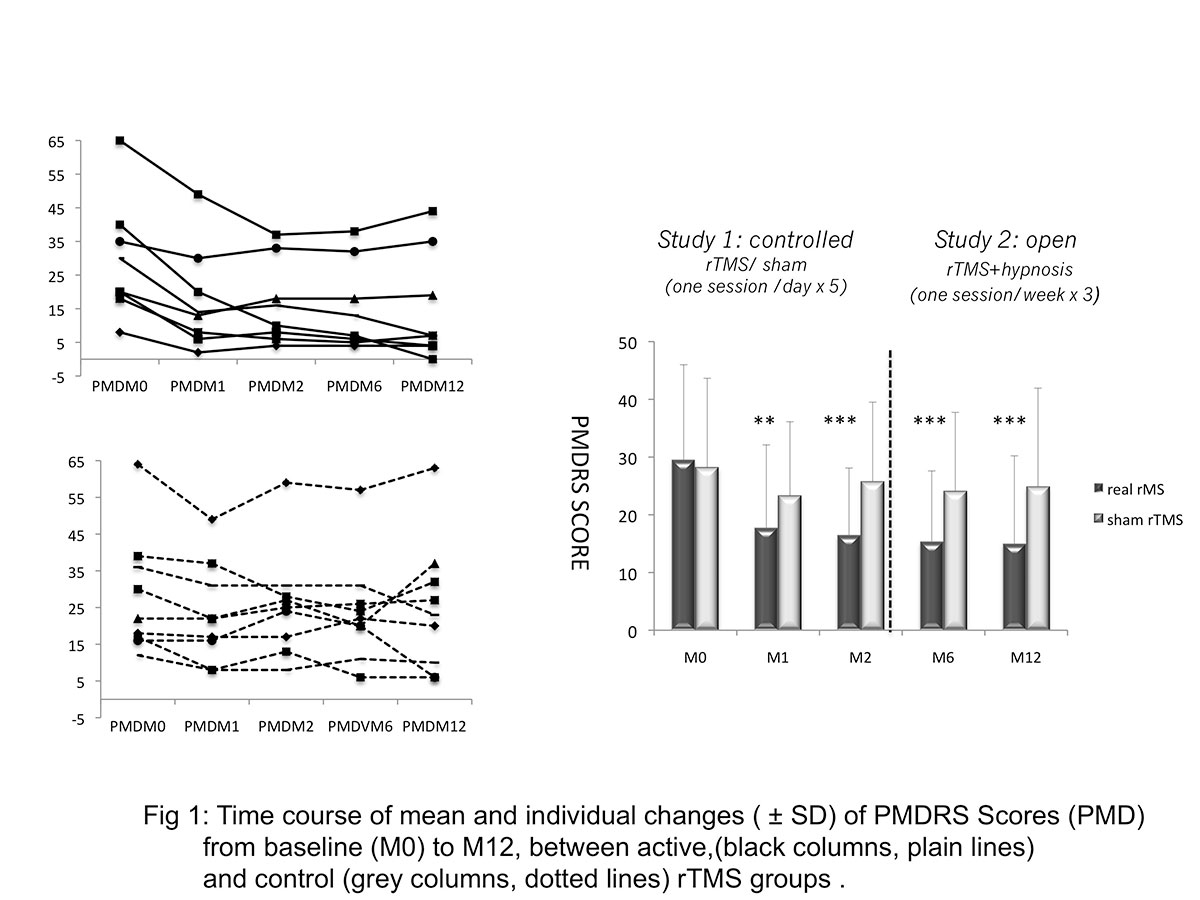Session Information
Date: Monday, September 23, 2019
Session Title: Functional (Psychogenic) Movement Disorders
Session Time: 1:45pm-3:15pm
Location: Les Muses Terrace, Level 3
Objective: To compare the effect on functional tremor (FT) of real rTMS vs sham and to test if hypnosis combined with rTMS might help to prolong any rTMS-induced therapeutic effect.
Background: Despite advances in our understanding of the neurobiological support and in clinical diagnosis of Functional Movement Disorders (FMD), there is a lack of published controlled therapeutic studies and indeed management of FMD remains challenging.
Method: The effect on FT of 5 consecutive daily sessions of real rTMS vs sham was compared, at one and two months (M1, M2), using a double-blinded randomized 2-arm parallel controlled design. In the second open-label phase, all the patients had 3 weekly sessions of hypnosis, combined with 3 single real rTMS sessions. Primary outcome was change of Psychogenic Movement Disorder Rating Scale, (PMDRS) total score at M1 compared to baseline. Secondary outcomes were changes in total and tremor PMDRS sub-scores, domains of SF-36 scale, Self-report Hospital Anxiety and Depression, Hamilton Depression Rating Scale, Clinical Global Impression, assessed at M1, M2, M6 and M12.
Results: 33 outpatients affected by FMD were screened and 18 fulfilling the inclusion criteria, (8M, 10F), were randomized. One month after the intervention the mean PMDRS score decreased in both groups but differences with baseline were only significant in the real rTMS group (p<0.001) and remained significant at M2 (p<0.001). Similar results were observed with mean tremor subscores (p<0.01). Significant changes from baseline values were maintained at M6 and M12 for the active group (p<0.001). For the control group, mean PMDRS returned almost to its baseline value as soon as the end of M2 and remained unchanged at M6 and M12. A significant improvement of the SF-36 general health domain was reported by the patients at M12, compared with baseline, for both groups whatever the intervention, (p=0.02), with a negative correlation between M12 PMDRS total or tremor subscores and M12 general health percentages: the lower the PMDRS or tremor scores at the end of the study, the higher the general health domain percentage (PMDRS r = -0.67 p= 0.02; tremor r= - 0.53 p= 0.05).
Conclusion: rTMS could represent a valuable therapeutic option in the management of FT, able to induce significant long-lasting decrease of symptoms, if applied with suitable parameters and combined with other therapies such hypnosis.
To cite this abstract in AMA style:
S. Taib, F. Ory-Magne, C. Brefel-Courbon, Y. Moreau, C. Thalamas, C. Arbus, M. Simonetta-Moreau. rTMS-induced effects on Functional Tremor: a randomized, double-blind, controlled study [abstract]. Mov Disord. 2019; 34 (suppl 2). https://www.mdsabstracts.org/abstract/rtms-induced-effects-on-functional-tremor-a-randomized-double-blind-controlled-study/. Accessed December 18, 2025.« Back to 2019 International Congress
MDS Abstracts - https://www.mdsabstracts.org/abstract/rtms-induced-effects-on-functional-tremor-a-randomized-double-blind-controlled-study/

